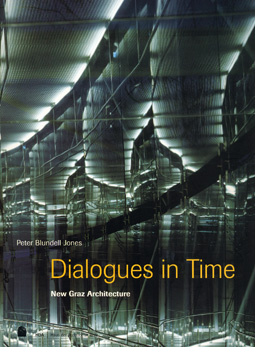
Foto: Karl Odorizzi (1)
Dialogues in Time
New Graz Architecture
Peter Blundell Jones
HDA Haus der Architektur
1998
ISBN 3901174362
The Studio Revolution
Just at the time when Domenig and Huth were beginning to attract attention with their concrete buildings, the Pedagogical Academy at Graz-Eggenberg and Church-centre at Oberwart, a movement was brewing among students of the architectural school at the Technical University, which is now remembered as the Zeichensaalrevolution or 'Studio Revolution'. It was an anti-establishment in a typically 1960s way, and belongs to an international context of burgeoning youth culture, the discovery of a new sense of freedom and the overturning of old social structures, which reached its climax in Paris in 1968. The participants give the impression that the so-called 'Revolution' happened in a particular year and to their particular generation, but the various accounts put together suggest that it was a rolling phenomenon over a number of years, becoming almost a school tradition, with origins back in the 1950s and some continuation in the 1970s....
The students increasingly took charge of their lives, setting their own agenda, discovering their own cultural heroes and key texts. They also plundered other disciplines:
'Someone would come in with a book which he was secretly reading. The others would notice and when he turned his back sneak a look it was Wittgenstein'.*
They clubbed together to buy the latest books and architectural magazines from abroad, and they forged links with architects and students in other cities. Some of them acknowledge receiving support from the staff, particularly Professors Hoffmann, Bieber and Schuster, but others disagree. Konrad Frey claims that only Schuster really supported the students, while Hoffmann on the contrary felt his authority as the local representative of the Bauhaus snubbed and even boycotted an invitation to Yona Friedmann. Heinz Wondra reports that the professors were simply helpless, for what was happening was out of their control. Schuster was gentlemanly and sympathetic, but with his elegant dress and good manners he seemed quite out of place in the wild and dirty studio among the empty beer-bottles. One of Wondra's friends Bernd Capra even rode a motorcycle through the university halls: it was all a little bit anarchic.**
The architectural ideas produced by the 'Studio Revolution' were anything but local. Ashamed of their provincial setting, the students turned to the outside world for inspiration. They lived through these connections, first on paper and then through personal contact....
School of Mautern
Of all the Graz architects from the first two generations of the studio revolution period, Wondra is the one who had most contact with the international Post-Modernist movement of the 1980s, being the only Graz participant in the controversial Forellenweg development outside Salzburg organised by Magnano Lampugnani and involving figures such as Aldo Rossi, Oswald Matthias Ungers and Rob Krier.*** This contact shows in the design of Wondra's school at Mautern, his most important work to date, in elements such as the applied entrance facade, the archetypal truss structure of the hall, and the idea of house-within-a-house (which appeared most famously in Ungers's Frankfurt Architecture Museum). It would be quite wrong, however, to dismiss Wondra's work on this basis as derivative for there are important social and contextual ideas behind it which reward deeper scrutiny than is afforded by a purely stylistic view.
Zitate:
Peter Blundell Jones
*
Heinz Wondra in an interview with the author of April 1998, author's translation.
**
Heinz Wondra in an interview with the author of April 1998.
***
write 'controversial' because this major incursion of the international post-modern scene into Austria was unwelcome to some and led to fierce criticism in the press, including a broadside from Prof. Hubert Hoffmann.


